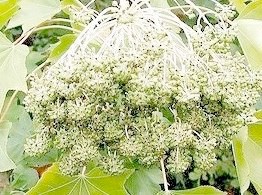Castor-aralia
(Acer pictum)

Description
Kalopanax septemlobus, common names castor aralia, tree aralia, and prickly castor oil tree, is a deciduous tree in the family Araliaceae, the sole species in the genus Kalopanax. It is native to northeastern Asia, from Sakhalin and Japan west to southwestern China. It is called cìqiū in Chinese, eumnamu in Korean, and harigiri in Japanese. The tree grows to 30 metres (98 ft) tall, with a trunk up to 1–1.5 metres (3.3–4.9 ft) diameter. The stems are often spiny, with stout spines up to 1 centimetre (0.39 in) long. The leaves are alternate, in appearance similar to a large Fatsia or Liquidambar (sweetgum) leaf, 15–35 centimetres (5.9–13.8 in) across, palmately lobed with five or seven lobes, each lobe with a finely toothed margin. The leaf lobes vary greatly in shape, from shallow lobes to cut nearly to the leaf base. Trees with deeply lobed leaves were formerly distinguished as K. septemlobus var. maximowiczii, but the variation is continuous and not correlated with geography, so it is no longer regarded as distinct. The flowers are produced in late summer in large umbels 20–50 centimetres (7.9–19.7 in) across at the apex of a stem, each flower with 4–5 small white petals. The fruit is a small black drupe containing two seeds.
Taxonomic tree:







